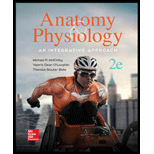
Anatomy & Physiology: An Integrative Approach
2nd Edition
ISBN: 9780078024283
Author: Michael McKinley Dr., Valerie O'Loughlin, Theresa Bidle
Publisher: McGraw-Hill Education
expand_more
expand_more
format_list_bulleted
Concept explainers
Question
Chapter 22.5, Problem 19WDYL
Summary Introduction
To determine:
The effect, if a T-lymphocyte that failed the negative selection test was not destroyed.
Concept introduction:
The newly formed T-lymphocyte must also not bind to any self-antigens that are present within an MHC molecule. The thymic dendritic cells are presented by self-antigens with MHC class I and II molecules (APC). T-lymphocytes that survive both positive and negative selection can bind an MHC molecule and recognize the foreign antigen.
Expert Solution & Answer
Want to see the full answer?
Check out a sample textbook solution
Students have asked these similar questions
What are lymphocyte clones? What is the differencebetween positive and negative lymphocyte selection?
What is the enzymatic tag on the antibodies that interacts with the substrate causing the color change?
The primary antibody detects the antigen of interest. What does the secondary antibody detect? If you secondary is a goat anti-rabbit antibody, what does that mean?
Chapter 22 Solutions
Anatomy & Physiology: An Integrative Approach
Ch. 22.1 - Which pathogen must enter a cell to replicate?...Ch. 22.2 - Prob. 2WDYLCh. 22.2 - What is the definition of a cytokine? How are...Ch. 22.2 - Prob. 4WDYLCh. 22.3 - Prob. 5WDYLCh. 22.3 - Prob. 6WDYLCh. 22.3 - How do NK cells accomplish the task of eliminating...Ch. 22.3 - Prob. 8WDYLCh. 22.3 - Prob. 9WDYLCh. 22.3 - Prob. 10WDYL
Ch. 22.3 - Prob. 11WDYLCh. 22.3 - Prob. 12WDYLCh. 22.4 - Prob. 13WDYLCh. 22.4 - What distinguishes a hapten from an antigen?Ch. 22.4 - Prob. 15WDYLCh. 22.4 - Which type of MHC class molecules is found on all...Ch. 22.4 - Prob. 17WDYLCh. 22.5 - Prob. 18WDYLCh. 22.5 - Prob. 19WDYLCh. 22.5 - Prob. 20WDYLCh. 22.6 - Prob. 21WDYLCh. 22.6 - How do cytokines released by helper T-lymphocytes...Ch. 22.6 - Prob. 23WDYLCh. 22.6 - Prob. 24WDYLCh. 22.6 - Prob. 25WDYLCh. 22.7 - Prob. 26WDYLCh. 22.7 - Prob. 27WDYLCh. 22.7 - Prob. 28WDYLCh. 22.8 - Prob. 29WDYLCh. 22.8 - What are the six major functions of antibodies?...Ch. 22.8 - Which subclass of antibodies is most prevalent?...Ch. 22.9 - Prob. 32WDYLCh. 22.9 - Prob. 33WDYLCh. 22.9 - Prob. 34WDYLCh. 22 - _____ 1. All of the following are phagocytic cells...Ch. 22 - _____ 2. This cell releases cytokines to activate...Ch. 22 - _____ 3. This cell is activated by binding...Ch. 22 - _____ 4. These two cells destroy an infected cell...Ch. 22 - _____ 5. All of the following are functions of...Ch. 22 - _____ 6. The four characteristics of adaptive...Ch. 22 - _____ 7. During which process does additional...Ch. 22 - _____ 8. This chemical is released by...Ch. 22 - _____ 9. The correct sequence of the major events...Ch. 22 - _____ 10. Two of the major actions of complement...Ch. 22 - Compare the general characteristics of innate...Ch. 22 - Define the inflammatory response, and explain its...Ch. 22 - Describe an antigen.Ch. 22 - Describe class I and class II MHC molecules, and...Ch. 22 - Prob. 15DYKBCh. 22 - Prob. 16DYKBCh. 22 - Explain the general function of cytotoxic...Ch. 22 - Describe both the function of antibodies and...Ch. 22 - There are two branches of adaptive immunity:...Ch. 22 - Prob. 20DYKBCh. 22 - Prob. 1CALCh. 22 - Prob. 2CALCh. 22 - Prob. 3CALCh. 22 - Prob. 4CALCh. 22 - Prob. 5CALCh. 22 - Prob. 1CSLCh. 22 - Prob. 2CSLCh. 22 - Prob. 3CSL
Knowledge Booster
Learn more about
Need a deep-dive on the concept behind this application? Look no further. Learn more about this topic, biology and related others by exploring similar questions and additional content below.Similar questions
- Herd immunity means that the entire population (not just those who are vaccinated) are protected from a disease. What is one way that herd immunity protects an unvaccinated person (such as an infant who is too young to be vaccinated or a person who is immunocompromised)?arrow_forwardConstruct a typical antibody (immunoglobulin) molecule. Label the variable and constant regions, and the light and heavy chains. Indicate which region determines the antibody’s isotype (class). Indicate which region determines its antigenic specificity.arrow_forwardHow would this illustration change if it showed class switching by B cells residing in Peyer’s patches?arrow_forward
- Why is it better to use an unlabeled primary antibody and a labeled secondary over just labeling the primary antibody?arrow_forwardWhy does antibody titer rise after infection? Is ahigh antibody titer indicative of an ongoing infection?Explainarrow_forwardWhat component must have been present in the positive control solution (antigen, anti-HIV IgG antibodies, or secondary antibody)? Explain how you know this is true.arrow_forward
- Cells from mouse spleen were fixed and stain with CD4, whichis found on T cells. Are the lighter green and black dots teh CD4?arrow_forwardWhy are helper T cells sometimes called CD4 or T4 cells?Why are cytotoxic T cells sometimes called CD8 or T8 cells?arrow_forwardWhat does a humoral immunity concept map look like with 10 words or phrases?arrow_forward
- What evidence led Emil von Behring to discover antibodies and the complement system in 1905?arrow_forwardWhat is the purpose of negative selection of B and T cells? Explain in one sentence.arrow_forwardTo diagnosis, we used a procedure known as a "sandwich ELISA" (Enzyme-Linked Immunosorbent Assay). 1.In the "ELISA sandwich," what is the "meat"? 2.Both patients A and B had positive results. Why are these two patients' outcomes so different? 3.What is one potential cause of an ELISA false negative result? What is one potential cause of an ELISA false positive result? What is another example of how an ELISA assay should be used?arrow_forward
arrow_back_ios
SEE MORE QUESTIONS
arrow_forward_ios
Recommended textbooks for you

An Introduction to the Human Genome | HMX Genetics; Author: Harvard University;https://www.youtube.com/watch?v=jEJp7B6u_dY;License: Standard Youtube License